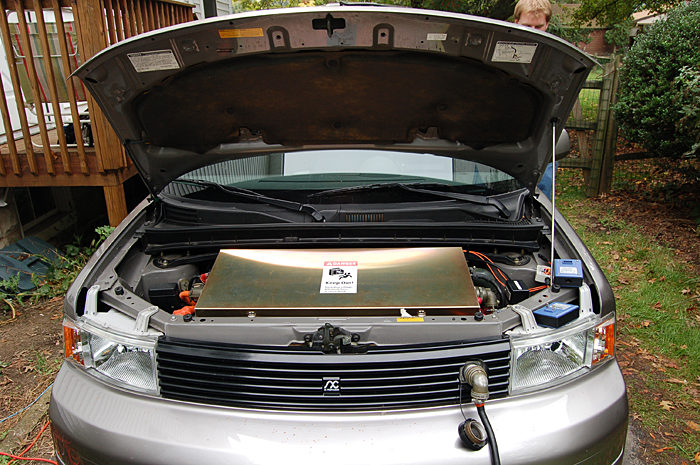
Image Credit: University of Delaware / Willett Kempton
During Peak Hours, Vehicles Could Sell Power to the Grid
NEWARK, DE — Researchers believe that electric cars may someday feed power to the grid during peak use hours. An East Coast electric utility, PJM Interconnection, is researching the feasibility of bi-directional electric vehicle chargers that let owners of garaged vehicles sell electricity to the grid during hot summer afternoons, when electricity use usually spikes.
In theory, a home with net metering and time-of-use billing could recharge a plug-in vehicle cheaply in the middle of the night and sell electricity at a higher rate the following afternoon. A car could even provide emergency power to a house during electricity blackouts.
Willet Kempton, a renewable-energy professor at the University of Delaware, is participating in the PJM research project. Kempton drives a Toyota Scion that underwent a $70,000 custom conversion that involved replacing the gasoline engine with electric motors and batteries. The electric car can travel up to 120 miles between charges.
Kempton now has a bi-directional charging station at his house. According to The Philadelphia Inquirer, “The battery in this new breed of electric car can both give and receive, taking a charge and then, through the same electrical cord, sending some of its stored energy back to a hungry electricity grid, as needed.”
Vehicle-to-Grid is “A Game-Changer”
PJM Interconnection is not the first utility to test so-called vehicle-to-grid technology. In California, Pacific Gas and Electric has run similar tests on a modified Toyota Prius. Southern California Edison is studying how many electric vehicles would be required to help the utility shave peak electricity use. Utilities are willing to invest significant sums to help lower late afternoon peak loads, since satisfying these usage spikes is technically difficult and costly. According to Edward Kjaer, Southern California Edison’s director of electric transportation, “Energy storage is not only a nexus between these two titans — the energy and auto industries — it’s a game-changer.”
PJM recently sponsored an electric-car conference in Valley Forge, Pennsylvania. The Philadelphia Inquirer reported, “Kempton’s car is a research project owned by the University of Delaware. It’s dubbed the MAGICC car — after the initials of the Mid-Atlantic Grid Interactive Cars Consortium, formed to further develop, test and demonstrate the technology. It was a star at the recent summit, ensconced in a big tent in the parking lot. The car was plugged in and sucking juice. Then, a PJM official sent out a signal from a grid computer just a few feet away, and within a second a nearby meter started spinning backward. The car was giving electricity back.”
According to the University of Delaware, “Kempton estimates the value for utilities could be up to $4,000 a year for the service, part of which could be paid to drivers.”
Using A Car to Power Your House
Although utility executives may not realize it, today’s vehicle-to-grid vision resembles a scheme developed in the 1970s by Jim Cullen, a California inventor and author who lived in the hills of Mendocino County. Cullen promoted the “Wilderness Home Power System,” a collection of hardware allowing an off-grid homeowner to run an extension cord between a parked car and 12-volt wiring in a backwoods cabin. As long as the car was driven daily to keep the vehicle battery charged, a small amount of electricity could be used each night for lighting, radio, and a small television. Cullen’s system was made obsolete in the 1980s by dropping photovoltaic module prices.
Weekly Newsletter
Get building science and energy efficiency advice, plus special offers, in your inbox.














0 Comments
Log in or create an account to post a comment.
Sign up Log in